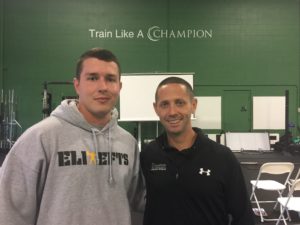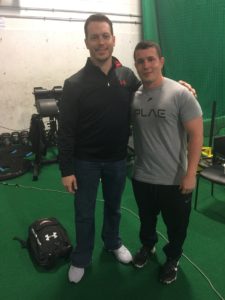One of my dreams is to have a stable of baseball players from all levels that I could help train and develop. I have played the game my whole life and know that an effective strength and conditioning program can make a big difference for these athletes.
I know there are special considerations that need to be taken when training overhead athletes like baseball players and made it one of my goals to attend a baseball-specific training seminar this year. The problem is, it is hard to find this type of event.
Throughout the year, I searched the internet to see if any of the baseball trainers I followed would be speaking at an event I could attend. It did not look like I was going to be successful until I got home from the Yankees-Indians ALDS Game 3 playoff game when I found the 2017 Champion Elite Pitching Performance Seminar on my Facebook feed. My trip to Massachusetts was booked shortly after and it was one of the best investments I have ever made.

Champion Physical Therapy and Performance is a one-stop shop for baseball players.
I found out about this event through Mike Reinold and his Elite Baseball Performance group, which has been one of my go-to resources for baseball information. Mike was joined by Brent Pourciau, Dan Blewitt, Lantz Wheeler and Paul Reddick to discuss all aspects of pitching from development, strength and power training, mindset, mechanics and the art of what it takes to be successful on the hill. Baseball is also a data-driven sport and we were treated to demos by industry-leaders Rapsodo, Motus and King of the Hill on some of the tracking technology and tools used to gage performance.
Atmosphere is everything and Mike’s facility, Champion Physical Therapy and Performance, was the perfect venue to host this event. If I was asked to put together my dream facility with an unlimited budget, it would look very similar to this place. This facility is an all-in-one stop that must have players salivating when they come in. Once you walk in, you see the physical therapy room which is adorned with jerseys of the Boston Red Sox players Mike has worked with.
Then you walk out to the training area where there is a section for conditioning, a strength training area lined up with all the necessities to build athletes and “The Farm”. The Farm is special. It is a netted-off turf area equipped with five batting areas and pitching mounds with buckets filled with official balls from all the leagues. It was an amazing experience just to walk around and see and I would love to observe it while they are in business training athletes.

Mike Reinold gave an in-depth presentation on training for pitchers.
Reinhold opened the seminar with a very interesting presentation that challenged a lot of what I read and learned about developing arm strength. He talked about how to properly long toss and how it can have diminishing returns if you are throwing from too far back. Weighted balls have become a hot topic in baseball and Mike talked about how all they do is get the arm to move faster. All the rage in baseball has been the increase in velocity, but Mike countered that by saying the top 20 players in Wins Above Replacement (WAR) value had an average velocity of 93 miles per hour, which I have heard to be considered an average fastball these days on TV broadcasts.
When it comes to developing pitchers properly, Mike, like most smart coaches, believes in low-risk, high-reward methods. The easiest way to develop pitchers, he said, is to optimize the body and clean it up through strength and dynamic stabilization. There are four buckets we need to consider to help pitchers reach their full potential and we need to make sure they are filled equally for kids — strength, arm care, throwing mechanics and age/maturity. There was a lot packed into this presentation as he went into how to approach each bucket and gave the biomechanics of velocity.
Mike also helped make my lunch break a productive one by answering every question I threw his way. The

Brent Porciau broke down how he trains strength and power with the pitchers he works with.
same could be said about Porciau, of TopVelocity.net and owner of Guerrilla Baseball Academy. His presentation went into ways we could develop high-velocity pitchers in the weight room without stressing the arm. He showed how he uses his 3X program with the two phases of a pitchers delivery: the stride phase and the throwing phase. What intrigued me about his talk was how he stressed the importance of strength and power training, which I did not expect, and how everything he discussed was science and research driven. Right after I talked to Mike, I was able to talk with Brent and broke down everything with me and had a great team with him. He introduced me to former big-league pitcher Mike Linskey, who could not have been nicer, and one of his athletes, Adam. Adam is only in high school, but he knew training like a seasoned coach. It took me a while to realize he was not one of Brent’s coaches. That is a testament to how well of a program Brent runs.
The seminar then shifted more into the art of pitching with Blewitt, who owns the Warbird Academy and hosts the “Dear Baseball Gods” podcast. What I loved with his presentation is how he gave you a template to use on how to assess yourself to develop your approach on the mound. I liked how he was able to present this information in a simple manner where anyone, regardless of age or skill level, could comprehend it fully. I wish I had this information in my hands when I was in high school. He provided an ideal pitch selection based on your arm slot and the pros and cons of having a high-spin, low-spin and average-spin fastball. It was interesting how he discussed the three important things that make up a good pitching sequence and how to use the information a hitter provides to your advantage. He even went into how to effectively pair your pitches for pitch tunneling. I went into this seminar focused on the strength and conditioning side, but his presentation made me want to toe the rubber on The Farm and try some pitches out.
Wheeler, the founder of The Baseball Think Tank, really made me think about how I communicate with my athletes with his three laws of development. The first two really stood out to me. The first law is inputs become outputs. If we are not clear with our communication, the movements will not be crisp. He stressed that it is so much more important for us to get into a player’s mind than their mechanics. This made me think of all the times I worked with a client and they were not able to perform a movement properly because I could not explain it well enough. The second is intention begat actions and he used a story about Bartolo Colon to explain it. Intent matters and there is a big difference between throwing while trying to hit a target as opposed to trying to break down a door with a ball. He said it is “mind over motor”. The third law is form over function. He went into how mechanics are developed through the body, how we need to disarm the body’s built-in alarms, since its main goal is to protect at all costs, and the “caveman mechanics” of pitching.
The presentations closed with Reddick, of the 567 Academy. I got the chance to hear Paul speak when I was at the CPPS weekend and heard him on Joe DeFranco’s podcast a few weeks prior to the event. Paul’s talk was more geared towards the athletes and parents in attendance, but my main takeaway was on doing the invisible work. This is the work that is self-directed and nobody sees. This is Kobe Bryant practicing at 5 a.m. and Manny Ramirez having his friends turn their cars on in the wee-hours of the morning so he can take extra hacks before school. This is the work I need to continue to do to get to where I want to be.
Overall, this was a fantastic event from top-to-bottom. It had been a long couple of weeks for me and I questioned whether or not I would be able to make the trip. I am certainly glad I did. After the presentations, Pourciau and Wheeler provided live demos on The Farm and King of the Hill, Motus and Raspodo showed us all the ways to use their devices. I left the event meeting some great people and with a much better arsenal on how to properly work with pitchers.